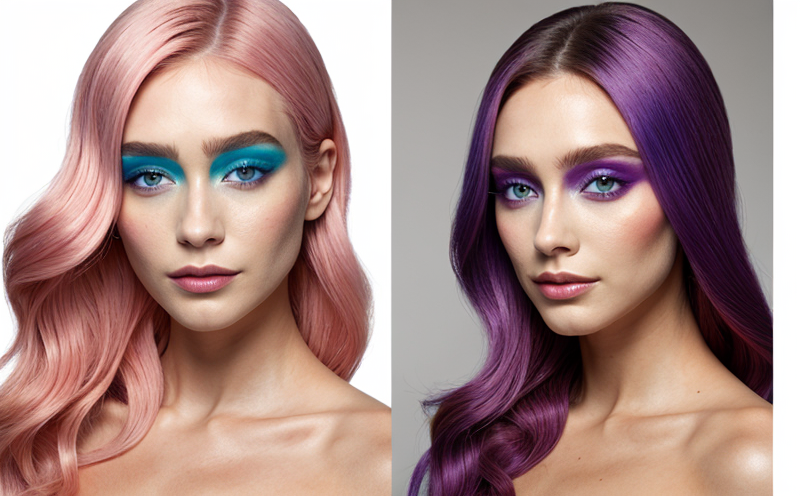Phototoxicity Testing in Color Cosmetics
The phototoxicity testing of color cosmetics is a critical step in ensuring product safety and compliance with international regulations. This test evaluates whether exposure to sunlight can cause harmful effects such as irritation, redness, or even more severe damage to the skin. For quality managers, compliance officers, R&D engineers, and procurement teams, this test is essential for verifying that color cosmetics meet stringent standards set by regulatory bodies.
The process involves simulating real-world exposure conditions under controlled laboratory settings using a combination of light sources and biological assays. The aim is to identify any potential phototoxic compounds that could lead to adverse effects when used in conjunction with sunlight. By conducting this test, manufacturers can ensure their products are safe for consumers while also maintaining brand reputation and market trust.
The testing procedure typically begins with selecting representative samples of the color cosmetic product. These samples undergo extensive preparation before being exposed to specific wavelengths of light. The choice of wavelength is crucial as it mimics natural sunlight conditions most likely to induce phototoxic reactions. After exposure, various biological assays are performed to measure changes in skin cells or other relevant indicators.
One key aspect of this testing method involves understanding the interaction between light and chemical compounds present in color cosmetics. Some pigments and preservatives may break down under ultraviolet (UV) radiation released by sunlight, potentially releasing irritants into the environment. Identifying these components early on allows manufacturers to reformulate their products if necessary.
Another important consideration is ensuring accurate and reproducible results across different batches of a product or between laboratories. To achieve this consistency, strict protocols must be followed during sample preparation, exposure duration, and assay procedures. Compliance with recognized international standards such as ISO 18923-1 provides assurance that the testing process adheres to industry best practices.
It is worth noting that phototoxicity testing goes beyond mere compliance; it serves as an opportunity for innovation within the cosmetic sector. By continuously improving test methods and incorporating cutting-edge technology, researchers can develop safer products without compromising on efficacy or appeal.
In summary, phototoxicity testing plays a vital role in safeguarding consumers from potential risks associated with sun exposure while supporting regulatory requirements globally. Through rigorous scientific investigation, companies not only protect public health but also enhance their commitment to sustainable development practices.
Scope and Methodology
| Step | Action | Description |
|---|---|---|
| 1 | Select Representative Samples | Pick up samples that are typical of the batch being tested. |
| 2 | Prepare Specimens | Cleanse and precondition specimens according to specified procedures. |
| 3 | Exposure to Light Source | Expose prepared specimens to controlled light sources simulating natural sunlight. |
| 4 | Analyze for Phototoxicity Indicators | Conduct biological assays to detect any adverse effects on skin cells or other relevant biomarkers. |
| 5 | Data Analysis and Reporting | Interpret results based on predefined criteria and generate comprehensive reports detailing findings. |
The scope of phototoxicity testing encompasses evaluating the safety profile of color cosmetics under simulated sun exposure conditions. This includes identifying any compounds that might react unfavorably when exposed to light, leading to potential health risks for consumers. The methodology follows established protocols outlined in international standards like ISO 18923-1, ensuring consistent and reliable outcomes.
Why Choose This Test
Choosing phototoxicity testing for color cosmetics offers several advantages that are crucial for maintaining product safety and regulatory compliance. Firstly, it helps manufacturers identify potential issues early in the development process, allowing them to address any concerns before launching a new product onto the market. Secondly, by adhering to rigorous testing procedures, companies can build consumer confidence and trust, which is vital given increasing scrutiny over ingredient safety and environmental impact.
Furthermore, phototoxicity testing ensures that products meet stringent regulatory requirements set forth by various authorities around the world. This not only prevents legal repercussions but also protects brands from reputational damage due to recalls or withdrawals. For R&D engineers working on new formulations, this test provides valuable insights into ingredient interactions and formulation adjustments needed to enhance product safety.
A key benefit lies in preventing adverse effects that could arise if consumers use the product incorrectly or expose it to excessive sunlight. By incorporating phototoxicity testing as part of their quality assurance program, manufacturers demonstrate a commitment to both consumer protection and sustainable practices. This proactive approach sets them apart from competitors who may overlook such critical steps.
In conclusion, opting for phototoxicity testing is essential for any company producing color cosmetics wishing to ensure high standards of safety and compliance. It offers peace of mind knowing that products meet all necessary criteria while paving the way for continued innovation within the industry.
Quality and Reliability Assurance
The quality and reliability assurance process in phototoxicity testing plays a pivotal role in ensuring accurate results and maintaining consistent standards across different batches or labs. To achieve this, several key measures are implemented throughout the entire testing procedure.
Firstly, strict adherence to established protocols is mandatory at every stage of sample preparation, exposure, and analysis. Compliance with international standards such as ISO 18923-1 ensures uniformity in methodology, reducing variability that could otherwise compromise reliability. Secondly, proper calibration and maintenance of all equipment used during the test are crucial for obtaining precise measurements.
Additionally, regular training sessions for personnel involved in conducting these tests help maintain expertise levels necessary for interpreting complex data accurately. Collaboration between multiple labs ensures cross-verification of results, further enhancing confidence in findings. Finally, robust quality control measures ensure that any discrepancies detected during the testing process are addressed promptly.
In summary, a comprehensive approach to quality and reliability assurance in phototoxicity testing guarantees accurate outcomes that uphold high standards for color cosmetic products across various markets globally. By implementing these rigorous practices, manufacturers can confidently introduce safe and effective formulations while complying with regulatory requirements.





